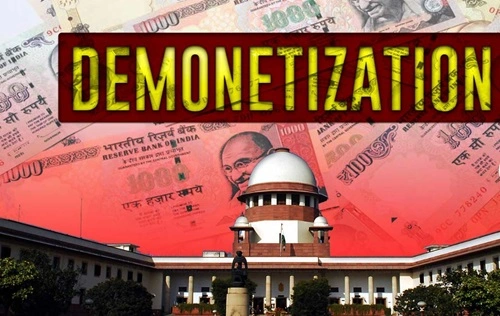Demonetization in India was a landmark event that reshaped the economic landscape of the country. Announced on November 8, 2016, by Prime Minister Narendra Modi, the government declared ₹500 and ₹1,000 currency notes—comprising 86% of the currency in circulation—invalid. The move was aimed at curbing black money, reducing corruption, combating counterfeit currency, and promoting digital payments.
While demonetization stirred significant debates among economists, policymakers, and the public, its impact continues to be a subject of critical analysis. This article examines the objectives, implementation, advantages, challenges, and long-term effects of demonetization in India.
Objectives of Demonetization

The government outlined several objectives for demonetization:
- Curbing Black Money: To eliminate unaccounted wealth stashed in the form of high-value currency notes.
- Reducing Corruption: By invalidating old notes, the government aimed to disrupt illegal transactions and activities.
- Tackling Counterfeit Currency: To combat the circulation of fake notes, particularly those used to finance terrorism.
- Promoting Digital Payments: To encourage a cashless economy and reduce dependency on physical currency.
- Increasing Tax Compliance: By bringing unaccounted cash into the formal banking system, the government sought to expand the tax base.
Advantages of Demonetization
1. Reduction in Black Money
One of the primary objectives of demonetization was to eliminate black money. During the note exchange process, a significant portion of unaccounted cash entered the banking system, providing greater transparency in financial transactions.
2. Boost to Digital Payments
Demonetization accelerated the adoption of digital payment methods such as UPI (Unified Payments Interface), e-wallets, and debit/credit cards. The shift toward digital transactions was evident with platforms like Paytm and PhonePe experiencing exponential growth.
3. Formalization of the Economy
The move compelled individuals and businesses operating in the informal sector to transition into the formal economy. This led to increased tax compliance and widened the tax base. Direct tax collections saw a noticeable uptick in subsequent years.
4. Increase in Financial Inclusion
Demonetization promoted financial inclusion as a large number of individuals opened bank accounts under schemes like Jan Dhan Yojana. This integration into the banking system empowered underserved populations.
5. Counterfeit Currency Decline
Demonetization effectively removed a significant amount of counterfeit currency from circulation. The replacement of old notes with new ones containing advanced security features reduced the ease of counterfeiting.
6. Short-Term Impact on Real Estate
The real estate sector, long considered a hub for black money transactions, experienced a slowdown. This curbed speculative activity and brought greater transparency to property dealings.
7. Awareness About Tax Evasion
The exercise highlighted the importance of tax compliance and created awareness about the need to formalize transactions, encouraging individuals to declare income honestly.
Challenges and Criticism of Demonetization
1. Economic Disruption
The sudden withdrawal of high-value notes created a severe cash crunch, disrupting daily life, especially for small businesses, farmers, and rural communities heavily reliant on cash transactions.
2. Decline in GDP Growth
India’s GDP growth rate fell from 8% in 2016 to 6.8% in 2017, according to official data. The slowdown was attributed to reduced consumer spending and industrial activity caused by the cash crunch.
3. High Cost of Implementation
The cost of printing new currency notes, recalibrating ATMs, and managing logistics was substantial. The RBI spent ₹7,965 crore on currency printing in FY17, compared to ₹3,421 crore in the previous year.
4. Return of Invalidated Notes
According to the Reserve Bank of India (RBI), over 99% of the demonetized currency (₹15.31 lakh crore out of ₹15.41 lakh crore) returned to the banking system. Critics argue that this undermined the goal of unearthing black money.
5. Impact on Informal Sector
India’s large informal economy, which relies heavily on cash, suffered significant disruptions. Daily wage workers, small traders, and farmers faced income losses due to the unavailability of liquid cash.
6. Digital Divide
While demonetization encouraged digital payments, rural and semi-urban areas with limited internet connectivity and low digital literacy faced challenges in adopting cashless methods.
7. Employment Losses
The economic slowdown following demonetization led to job losses, particularly in labor-intensive sectors like construction, textiles, and small-scale manufacturing.
8. Insufficient Preparation
The abruptness of the announcement and lack of adequate preparation—such as sufficient supply of new currency notes—led to chaos and long queues outside banks and ATMs.
9. Questionable Impact on Corruption
Critics argue that demonetization failed to address systemic corruption, as illegal wealth often takes the form of assets like gold, real estate, or offshore accounts, rather than cash.
10. Stress on Banking System
The unprecedented volume of cash deposits and withdrawals overwhelmed the banking infrastructure, causing operational inefficiencies and inconvenience to customers.
Long-Term Effects of Demonetization
1. Digital Payments Ecosystem
Demonetization catalyzed the growth of India’s digital payments ecosystem. The launch of UPI and the proliferation of fintech platforms have made cashless transactions more accessible and convenient.
2. Increased Tax Compliance
The government reported an increase in the number of tax returns filed post-demonetization, indicating improved compliance. However, the impact on actual tax revenue growth remains debated.
3. Real Estate Sector Reforms
The demonetization exercise, combined with policies like the Real Estate (Regulation and Development) Act (RERA), brought greater transparency and accountability to the real estate sector.
4. Behavioral Change
The move encouraged individuals and businesses to adopt formal banking channels, reducing reliance on cash. This shift aligns with the government’s vision of a digital and transparent economy.
Critical Perspectives
Supporters’ Viewpoint
Proponents of demonetization argue that it was a bold step toward formalizing the economy, reducing black money, and fostering digital transformation. They view it as a long-term reform that laid the foundation for subsequent economic initiatives like GST and DBT (Direct Benefit Transfer).
Critics’ Viewpoint
Critics contend that demonetization caused more harm than good, with limited evidence of its effectiveness in curbing black money or corruption. They emphasize the disproportionate impact on vulnerable sections of society and the informal sector.
Lessons Learned
- Importance of Planning: Sudden implementation led to significant disruptions. Future reforms should involve thorough planning and phased rollouts.
- Need for Robust Infrastructure: Strengthening banking and digital payment infrastructure is essential to ensure smooth transitions.
- Addressing Structural Issues: Tackling black money requires comprehensive measures, including reforms in taxation, real estate, and electoral funding.
- Balancing Short-Term and Long-Term Goals: Policymakers must weigh the immediate consequences of reforms against their long-term benefits.
Conclusion
Demonetization was a watershed moment in India’s economic history, reflecting the government’s resolve to address critical issues like black money and corruption. While it achieved some success in promoting digital payments and formalizing the economy, its execution and outcomes have been subject to intense scrutiny.
The mixed results of demonetization highlight the need for a balanced approach to economic reforms. Comprehensive planning, stakeholder engagement, and robust infrastructure are critical to ensuring that ambitious initiatives achieve their intended objectives without causing undue hardship. Demonetization’s legacy serves as a valuable lesson for future policymaking, underscoring the importance of aligning bold decisions with meticulous execution.

